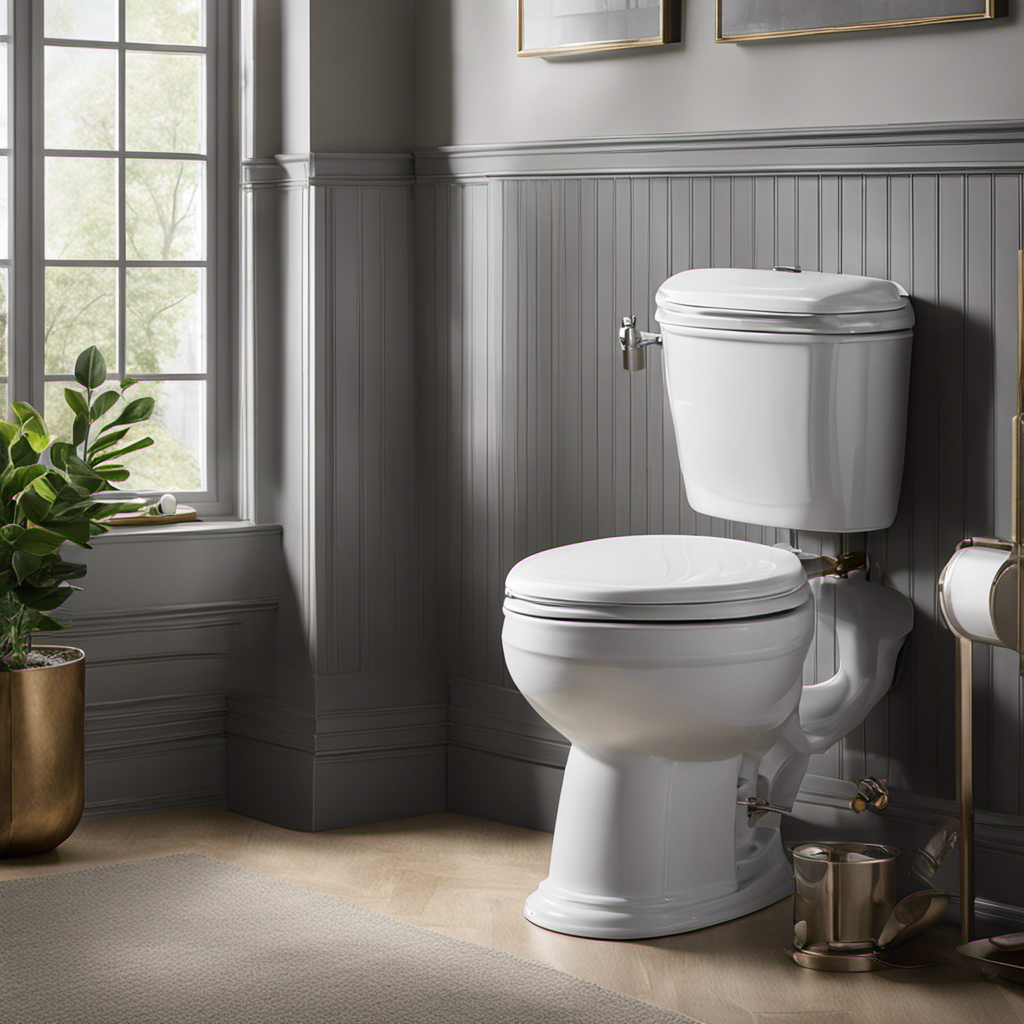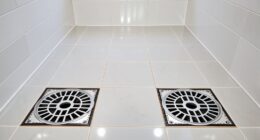I’ve been there before. You flush the toilet, and suddenly, water begins to rise, threatening to overflow onto your bathroom floor.
It’s a frustrating and messy situation, but fear not – there are steps you can take to stop an overflowing toilet.
In this article, I’ll share practical tips and techniques to help you understand the causes of toilet overflow, shut off the water supply, clear blockages, and even prevent future incidents.
Let’s dive in and solve this issue once and for all.
Key Takeaways
- Understanding the causes of toilet overflow, such as clogged toilets, faulty flapper valves, and blocked vent pipes
- Assessing the water level and shutting off the water supply to prevent further overflow and minimize damage
- Clearing the blockage with a plunger by creating a tight seal, applying downward pressure, and dislodging the blockage
- Using a plumbing snake to remove stubborn clogs by inserting it into the drain, rotating the handle, and avoiding common mistakes
Understanding the Causes of Toilet Overflow
To understand why your toilet is overflowing, you need to know what causes it. There are several common toilet plumbing issues that can lead to an overflow.
One of the most common causes is a clogged toilet. Signs of a clogged toilet include slow-draining water, gurgling sounds, and a water level that rises higher than usual after flushing.
Another possible cause is a faulty flapper valve. This valve controls the flow of water from the tank to the bowl, and if it doesn’t close properly, water can continuously flow into the bowl, causing an overflow.
Additionally, a blocked vent pipe can also lead to toilet overflow. This pipe allows air to enter the plumbing system and if it becomes blocked, it can disrupt the flow of water and cause backup.
Understanding these causes can help you diagnose and fix the issue before it leads to a messy overflow.
Assessing the Water Level and Shutting Off the Water Supply
First, I check the water level in the toilet and turn off the water supply. This step is crucial when dealing with an overflowing toilet. By evaluating the water level, I can determine the severity of the situation and take appropriate action.
Turning off the water supply prevents further water from entering the toilet bowl and exacerbating the problem. It is essential to act quickly to minimize damage and avoid a messy situation.
In some cases, seeking professional help may be necessary, especially if the overflow persists or if there is significant damage to the plumbing system. However, if the blockage seems minor, I can proceed to the next step of clearing the blockage with a plunger.
Clearing the Blockage With a Plunger
Now you can grab the plunger and position it over the drain to start clearing the blockage. Plunging is one of the most effective methods for unclogging a toilet.
Make sure the plunger forms a tight seal around the drain, creating a vacuum. Apply downward pressure and then pull up sharply, repeating this motion several times. The suction created by the plunger will dislodge the blockage and allow the water to flow freely again.
If the water level starts to rise while plunging, remove the plunger quickly to prevent overflow.
It’s important to remember that regular toilet maintenance can help prevent blockages in the future. This includes avoiding flushing large amounts of toilet paper or non-flushable items.
If you’re confident in your DIY plumbing skills, plunging is a simple and effective solution for a clogged toilet.
Using a Plumbing Snake to Remove Stubborn Clogs
If you’re dealing with a stubborn clog, try using a plumbing snake to clear it. A plumbing snake, also known as a drain auger, is a handy tool that can help you unclog your toilet without the need for harsh chemicals or expensive plumbing services.
To use a plumbing snake, simply insert the snake into the toilet drain and rotate the handle to break up the clog. However, there are some common mistakes to avoid when using a plumbing snake.
First, make sure to use the appropriate size of snake for your toilet drain. Using a snake that is too small may not effectively clear the clog, while using a snake that is too large can cause damage to your pipes.
Additionally, be sure to rotate the snake in a clockwise motion to ensure it effectively breaks up the clog. By following these tips, you can successfully use a plumbing snake to remove stubborn clogs and avoid costly plumber visits.
Preventive Measures to Avoid Toilet Overflow in the Future
To prevent future incidents, you should regularly inspect your toilet for any signs of blockages and promptly address them. Proper maintenance and regular inspections are key to avoiding toilet overflow. Here are some preventive measures you can take:
-
Monitor water flow: Keep an eye on the water level in the toilet bowl. If it seems higher than usual or takes longer to drain, there could be a blockage.
-
Avoid flushing inappropriate items: Only flush toilet paper and human waste down the toilet. Avoid flushing items like wet wipes, feminine hygiene products, or excessive amounts of toilet paper.
-
Install a toilet overflow alarm: This device will sound an alert if the water level in the toilet bowl rises too high, giving you time to address the issue before it overflows.
-
Schedule professional inspections: Regularly hire a plumber to inspect your toilet and plumbing system for any potential issues or blockages.
Conclusion
In conclusion, dealing with an overflowing toilet can be a messy and stressful situation. However, by understanding the causes, assessing the water level, and using the right tools such as a plunger or plumbing snake, you can effectively clear the blockage and prevent future overflows.
Remember to always shut off the water supply before attempting any repairs. With these simple steps, you can confidently handle any toilet overflow situation and maintain a functioning and hassle-free bathroom.
So next time you encounter a toilet overflow, don’t panic, just follow these practical tips and you’ll be back to a clean and functional toilet in no time.










